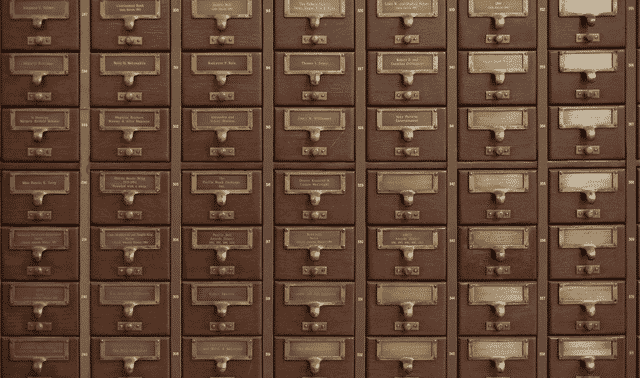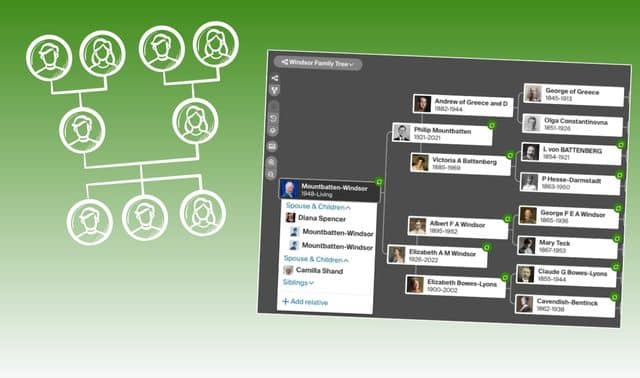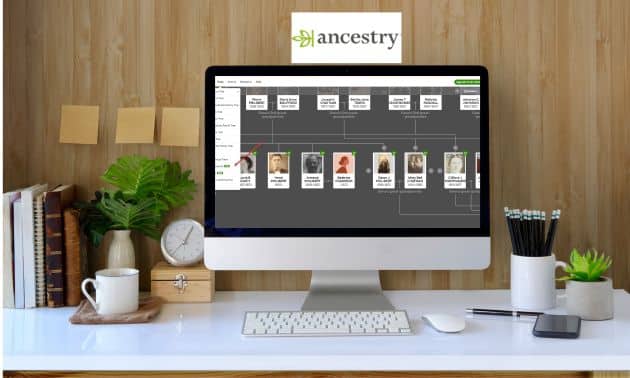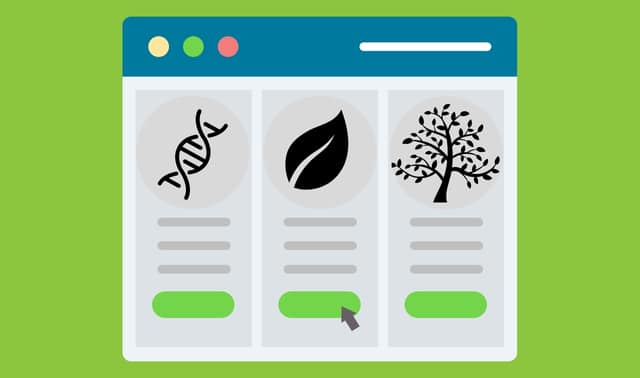Sign up for the Family Tree Newsletter Plus, you’ll receive our 10 Essential Genealogy Research Forms PDF as a special thank you!
Get Your Free Genealogy Forms
"*" indicates required fields

Article written by Gena Philibert-Ortega unless otherwise noted
How do you search Ancestry.com? Since it’s one of the biggest names in genealogy, you’ve likely been using Ancestry.com for years—maybe even since you first started your genealogy journey. But sometimes the way we’ve been using it isn’t the best or most effective.
The site continues to evolve, but its fundamental infrastructure is the same as it’s always been. And in this article, we’ll go back to the time-tested basics of searching genealogy records on Ancestry.com.
ADVERTISEMENT
Accessing Genealogy Records
There are three basic ways you can look for records online: searching by keyword, searching by collection or type of record, or browsing.
Ancestry.com also provides hints, which connect records in Ancestry.com’s database with people in your family trees.
Searching by Keyword
Ancestry.com’s basic search form is the one you see by default on your For You page. That search form has just basic fields—first and last name, estimated birth year and possible location—making it good for ascertaining what might be available, but not for later stages of your research. Broad searches using terms like these will likely produce too many results, particularly if you have an ancestor with a common name.
ADVERTISEMENT
Advanced Search (or Search > All Collections from the main menu) provides many more options—see the next section for more details. In addition to name, birth year and place, you can also search by:
- other life events (death, marriage, etc.)
- family members
- gender
- keywords
And you can limit your search to records only of specific types, or those from specific countries or ethnicities. If you have a family tree on the website, the form will suggest matching profiles as you type names. If you select it, the shortcut will auto-populate the rest of the fields with data about the person.
For basic details (name, year and place), Advanced Search allows you to adjust how closely you want the engine to match your search terms:
- “Exact” underneath a field limits your results to words that have the same spelling, or you can add phonetically similar names or names with the same Soundex profile or (for first names) initials.
- “Similar” searches will help you find name variations (such as John and Johnathan). And initials come in handy in records that tended to use first initials and surnames, rather than both first and last names.
- Soundex will be familiar to long-time family historians; this tool sorts names by how they sound phonetically, not how they’re spelled.
Likewise, you can search by places and dates using different levels of detail. Search locations (which can be any place the person lived or had a life event, not just birthplaces) using just a country, or drill down to a specific county or city. Make sure you select Ancestry.com’s suggestion for a standardized place name, as that will give you more refinement options later.
For years, you can use a drop-down to specify either the exact year or plus or minus one, two, five or 10 years. That allows for some “fuzziness” if you’re not sure exactly when an event took place.
There’s a downside to searching with many fields or by strict criteria, however. If you add too much information, you may filter out relevant hits that happen to not contain that extra detail. Try to match the level of detail to the kind of record you’re researching—for example, a “Lived In” place for a census or a spouse’s name for a marriage record.
A Detailed Look: Ancestry.com’s Search Form
By Nancy Hendrickson
Let’s go through each part of the search form and discuss how best to use it in your search. As you follow along, log in to your Ancestry.com account and try searches for someone in your family.
A. by Name
B. by Location
C. by Date
D. by Family Member
E. by Keyword
F. by Gender and Race/Nationality
G. by Collection Focus
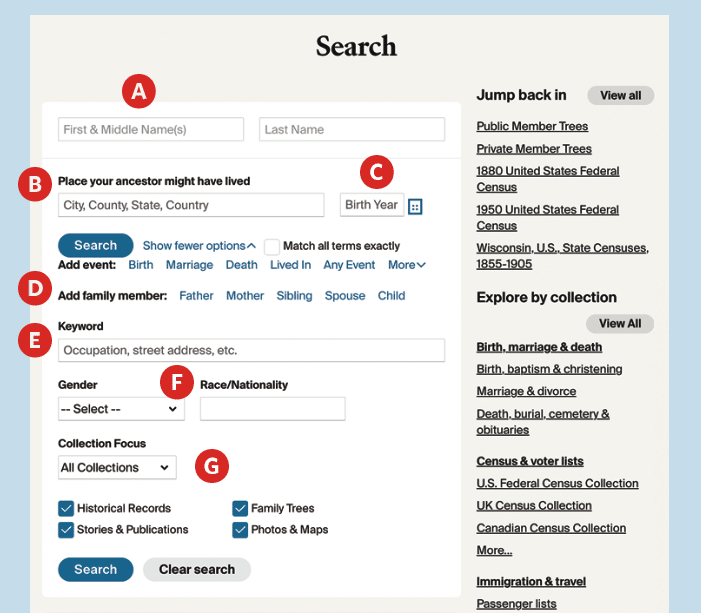
E (Keyword) F (Gender and Race/Nationality) G (Collection Focus)
A. by Name
Enter your ancestor’s first, middle (if you know it) and last names. Click “Exact” underneath, and several filter options pop up. These let you specify how broad you want to search. No filters checked is the broadest search, which is a good starting point, or check one or more of these filters:
- Exact: Find only records with the names exactly as you typed them.
- Sounds Like: This uses various algorithms to find records with names similar to what you typed.
- Similar: This option finds records with common variant spellings and alternate forms of the name you typed, including common nicknames for given names. It’s also a good idea to try separate searches with nicknames instead of given names, especially any unusual ones.
- Soundex (surname only): This finds surname variants that have the same Soundex system code as the one you typed (read about the system at the National Archives).
- Initials (first/middle name only): This includes records that have only first and/or middle initials matching the name you typed. The name fields let you search with wildcard characters to find variants. The * represents zero to five characters; the ? represents one character. You can use a wild card for the first or last letter, but not both, and names must contain at least three non-wildcard letters.
If you have a family tree on Ancestry.com, the site may try to autofill the form with a person from your family tree. For example, when I start typing the name Calvin into the First and Middle Names box, Ancestry.com suggests “Calvin Manlieus Dimmitt” from my tree. If the suggested person isn’t the person you want to find, ignore it and continue typing the name you need.
If the suggestion is the person you’re searching for, click the name to autofill the search boxes with the person’s name, birth date and place, family members’ names, etc. You then can change or remove the content in each field, depending what you’re looking for. If you want a married woman’s death record, for example, delete her maiden name from the search box. If you’re searching for census records from her childhood, remove her married name, as well as her spouse’s and children’s names from the family members area of the search form (which we’ll discuss in a bit).
Try running multiple searches with the names entered in different ways. For instance, if your ancestor’s name was John Albert Johnson, you may have to type the name as John Johnson, John Albert Johnson, J. Johnson or J.A. Johnson. I’ve also seen people listed on censuses with the middle name first, or by only a middle name. As you do more searches, you’ll become more adept at spotting potential name anomalies.
Ancestry.com may return records that don’t match the first name you typed in, but strongly match other criteria included in your search. If a result matches all criteria save the name, it’s worth taking a closer look at the record.
B. by Location
Our ancestors moved around more than we might realize, and their records may give different places of birth or refer to the same place with different names. So it’s helpful to allow for location variations when searching for people in records. Once you begin typing a location name in Ancestry.com’s search form, the “place picker” will serve up suggested place names to help you choose the location assigned in Ancestry.com’s indexes. Choose a suggested place, or you won’t get search results.
Like the name fields, filling location fields also brings up filters that let you narrow your search. No filters checked is your broadest option: It’ll return any records matching your other criteria, with those that also match this place prioritized at the top of the list. Or you can check one of the filters to narrow your matches to records from
- exactly the place you entered
- exactly the county where the place is located
- the county where the place is located, plus surrounding counties
- the state where the place you entered is located
- the state and adjacent states
- the country where the place you entered is located
Adding a “Place your ancestor might have lived” helps focus your search. You also can add places where other life events, such as birth or death, happened by clicking on that event in the “Add event” area. Click Lived In to add another place the person might’ve lived. Click More to add a port of arrival or departure (if you’re searching immigration records), or place of military service. If you click Any Event, your search will return records in which the person named has any life event occurring in the location you entered.
C. by Date
Adding a birth year to your Ancestry.com searches can help you distinguish among records of people who had similar names and lived in nearby places. This is particularly helpful if your ancestor had a common name, or if another family of the same surname also lived in his community. Do you know an ancestor’s age, but not a birth year? Click the calculator icon to figure out an ancestor’s birth year based on how old he was in a particular year (such as during a US census).
You’ve probably noticed that our ancestors often were inconsistent about their ages and birth dates in genealogical records. Many weren’t overly concerned with keeping track of their ages. Some people didn’t know their own birthdays, particularly in the years before official birth records were kept. And, just as with names, whoever wrote down a person’s birth date or age on a record might get it wrong.
The search form’s date fields offer filters to help you find records in which your ancestor’s birth date is off by one, two, five or 10 years in either direction from the year you entered. You also can search for records with exactly the year you entered.
If you’re searching for a relative’s death records, click Death under Add Event, and enter the year of death. You can add a date range, just as for a birth year. If you’re searching for census, marriage or other records—but not death records—it’s best to leave this field blank. That’s because most records about your ancestor were created while he was alive, and won’t contain anything in the death field.
If you don’t use any date ranges, your results will include records from all years, with the closest matches to other criteria ranked highest. To get more-manageable results, it’s important that you add a date for at least some life event, even if it’s just an educated guess.
D. by Family Member
This section of the search form allows you to add the name of a family member who’s likely to appear in documents such as censuses, passenger lists and vital records along with your relative. This could be a parent, sibling, spouse or child. Click the relationship to add the person’s name.
When you enter a name, an Exact box appears below the field. If you check it, you’ll see only results in which that name appears in the record along with your target relative. If you don’t check it, results containing the name you enter will rank higher in your results.
Adding a family member is especially helpful when working with ancestors who have common names. Or if you’re searching for an ancestor’s marriage record, add the spouse to your search (use a woman’s maiden name). You also can use this section of the search form to find records of children born to a couple: Enter the names of an ancestral couple in the fields for Mother and Father, leaving the main first and last name fields blank. Try both a maiden and married name for the mother, as birth records might give the name either way.
E. by Keyword
The Keyword box is another way of filtering for better results. For example, if you know that you’re seeking a person who served in the armed forces during the Revolutionary War, enter revolutionary war. (It’s not necessary to capitalize words in the search boxes.) Putting quotation marks around keywords (“revolutionary war”) tells Ancestry.com that exact phrase must appear in records matching your search.
F. by Gender and Race/Nationality
These fields let you specify the gender and race or nationality associated with the person you’re searching for. The latter field has an Exact checkbox. It’s usually best to leave these options blank, as they’re less important than other fields in narrowing your search. Using these fields may, in fact, filter out relevant records that didn’t happen to specify these fields.
That said, typing a general race or nationality, such as German or black may help when you’re searching for immigration or census records, in which these details might be recorded.
G. by Collection Focus
The last section of the search form lets you target your search more precisely by narrowing results to certain collections. As Ancestry.com increases its international content, this is a handy way to view only records related to your ancestors’ places. A dropd-own menu lets you select a particular place or an ethnicity (Black, Jewish or Native American—groups for which records often cross national boundaries). I encourage you to use this option if you know where a person lived. For example, if an ancestor lived his entire life in Canada, select Canada as the collection focus to return only records that are identified as Canadian records.
Optionally, you can choose All Collections. If your ancestor lived in multiple places (such as first in the United Kingdom, then Canada, and then the United States), try doing multiple searches, each with a different collection focus.
At the bottom of the search form, you’ll see checkboxes by four collection types:
- Historical Records: censuses, passenger lists, draft registrations and other records
- Stories & Publications: newspapers, published family histories and stories attached to public family trees
- Family Trees: profiles in family trees other Ancestry.com members have posted (if the tree is private, you can message the person through Ancestry.com)
- Photos & Maps: images (not necessarily just photographs) attached to family trees, as well as gazetteers and maps
Check the box next to each type of record you want searched. You might want to see only documents, for example, or you might be hoping for a photo of your great-grandfather. If you’re just starting your search, leave all the boxes checked to get as many results as possible, then refine your search to eliminate what you don’t find helpful.
Many Ancestry.com users have no idea the breadth of records available on the site because they
Gena Philibert-Ortega
only search from the home page.
Searching by Collection or Place
Ancestry.com’s general search forms may generate too many results to reasonably sort through. Fortunately, the site also lets you search smaller groups of documents:
Explore by Collection: From the right-hand side of the Advanced Search page, you can select a type of record—for example, Census & Voter Lists. Each category and collection has its own search page, making it easier to tailor a query or browse through records. That will help you find only results that are of that record type.
Explore by Location: That same page has a clickable map, with options for the United States and each of five continents (plus Oceania). Note the immediate US view doesn’t include places like Alaska, American Samoa and Puerto Rico, but you can find them in the list under the map. Click a state or country in the map to see a list of record collections. Or click the name of a state or country under the map to go to a unique landing page, which collects relevant record collections and allows you to drill-down even farther. This is helpful for determining if Ancestry.com even has records from the place and time period you’re looking for.
Explore by Database: Each Ancestry.com collection has its own search form, catered specifically to that kind of record. You can get to an individual collection by drilling down by location or record type, or by using the Card Catalog. (More on this soon.) In addition to limiting the number of results you have to sift through, searching by collection allows you to add more terms than a general search. Some records may only have fields for name and date, while others include more. For example, the 1950 US census form includes fields for details such as Hours Worked and Employment Status, as these were asked of respondents. By comparison, those details weren’t asked in the 1880 census, so that census’ search form is different.
Browsing Records
Visit an individual collection’s page, and you’ll likely also see an option for browsing that collection. When browsing, you page through record collections image-by-image—not unlike using microfilm readers in a library, FamilySearch Center, or archive.
This option is important if keyword searches aren’t giving you the results you’re hoping for, or if you want to view pages before or after your ancestor’s entry in a record set (e.g., for cluster and collateral research). You won’t be able to browse collections that are not imaged—i.e., that are index-only.
On the right side of a collection page, find the options under Browse This Collection. These will vary based on what collection you’re viewing, but generally include country, state, and county, then maybe a city. Censuses will have options such as enumeration districts; look these up by address using tools like Steve Morse’s One-Step Webpages.
Once you’ve drilled down, you’ll view records as organized in the microfilm collection. Use the arrows to move forward and backward between images, or click the thumbnails at the bottom of the screen to go to that page. If the collection is indexed, click the small person icon to toggle the index (which might help you more easily find relevant parts of the record).
Finding Collections in The Card Catalog
The Card Catalog is probably Ancestry.com’s best-kept secret. What is it, and why should you use it?
Ancestry.com has 33,000 record collections and counting. Like libraries, the website has created a card catalog to help users better work through that collection. The catalog also allows you to access records that haven’t been indexed (that is, records that are not yet keyword searchable): historical postcards, the Sears catalog, and photos of passenger ships. Indeed, many Ancestry.com users have no idea the breadth of records available on the site because they only search from the home page.
Start by clicking Search > Card Catalog or visiting here. Much like records themselves, you can search for collections by title or keyword or by using filters for record type, place or time period. Searching by title is tricky unless you know the exact name of the collection to the precise letter; in most cases, you’ll be better off searching by keywords such as census or birth records.
If you use the filters, you’ll have additional options by clicking the arrow next to each word. You can apply multiple kinds of filters—for example, Census & Voter Lists only for Canada in the 1880s. Each filter will result in more-exact results.
Sort collections by title, number of records, date added, or date updated. Ancestry.com is always adding new collections, so “Date Added” is an especially helpful way of identifying collections that have come online since you last visited.
Searching Family Trees and Users
Genealogical records aren’t the only resources you can search on Ancestry.com. You can also delve into the millions of family trees that other users have built. Select Family Trees as a record type in Basic or Advanced Searches, or search them individually by clicking Search > Public Member Trees.
Search by name, event date, and location. You can also add other family members, such as spouses and parents. A notice on the collection page reminds users that not all information will be in English, so you may want to search using more-standardized place names, naming patterns, and foreign-language keywords.
You can also search user-created trees that are marked as private, though you’ll need to request the owner for permission to view them.
Don’t forget about searching for users themselves! Among them may be recent family members, including those who have research and photos relevant to you. Click Search > Member Search or visit this link. You can search by user names or real names, and results indicate when they joined and when they last signed in. Message them using Ancestry.com’s in-site service—no email address required.
How Will You Search?
Ancestry.com collections, family trees, and DNA tools are vital in learning more about our ancestors. Equally important is using all of what Ancestry.com offers, including various search methods. Trial and error is one of the best ways to learn how to search for ancestral family. Try varied searches to see what you come up with.
Next time you use Ancestry.com, ask yourself, “How should I search to find what I need?”
Versions of this article appeared in the July/August 2024 (Philibert-Ortega) and March/April 2018 (Hendrickson) issues of Family Tree Magazine.
Related Reads
ADVERTISEMENT

